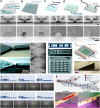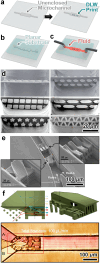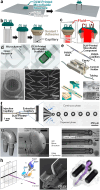Direct laser writing-enabled 3D printing strategies for microfluidic applications
- PMID: 38576361
- PMCID: PMC11060139
- DOI: 10.1039/d3lc00743j
Direct laser writing-enabled 3D printing strategies for microfluidic applications
Erratum in
-
Correction: Direct laser writing-enabled 3D printing strategies for microfluidic applications.Lab Chip. 2024 Apr 30;24(9):2590. doi: 10.1039/d4lc90040e. Lab Chip. 2024. PMID: 38647182 Free PMC article.
Abstract
Over the past decade, additive manufacturing-or "three-dimensional (3D) printing"-has attracted increasing attention in the Lab on a Chip community as a pathway to achieve sophisticated system architectures that are difficult or infeasible to fabricate via conventional means. One particularly promising 3D manufacturing technology is "direct laser writing (DLW)", which leverages two-photon (or multi-photon) polymerization (2PP) phenomena to enable high geometric versatility, print speeds, and precision at length scales down to the 100 nm range. Although researchers have demonstrated the potential of using DLW for microfluidic applications ranging from organ on a chip and drug delivery to micro/nanoparticle processing and soft microrobotics, such scenarios present unique challenges for DLW. Specifically, microfluidic systems typically require macro-to-micro fluidic interfaces (e.g., inlet and outlet ports) to facilitate fluidic loading, control, and retrieval operations; however, DLW-based 3D printing relies on a micron-to-submicron-sized 2PP volume element (i.e., "voxel") that is poorly suited for manufacturing these larger-scale fluidic interfaces. In this Tutorial Review, we highlight and discuss the four most prominent strategies that researchers have developed to circumvent this trade-off and realize macro-to-micro interfaces for DLW-enabled microfluidic components and systems. In addition, we consider the possibility that-with the advent of next-generation commercial DLW printers equipped with new dynamic voxel tuning, print field, and laser power capabilities-the overall utility of DLW strategies for Lab on a Chip fields may soon expand dramatically.
Conflict of interest statement
There are no conflicts to declare.
Figures











References
-
- Göppert-Mayer M. Über Elementarakte mit zwei Quantensprüngen. Ann. Phys. 1931;401:273–294. doi: 10.1002/andp.19314010303. - DOI
-
- Göppert-Mayer M. Elementary processes with two quantum transitions. Ann. Phys. 2009;521:466–479. doi: 10.1002/andp.200952107-804. - DOI
-
- Maiman T. H., Ruby Laser Systems, U.S. Pat., 3353115, 1960
-
- Kaiser W. Garrett C. G. B. Two-Photon Excitation in CaF2: Eu2+ Phys. Rev. Lett. 1961;7:229–231. doi: 10.1103/PhysRevLett.7.229. - DOI
Publication types
Grants and funding
LinkOut - more resources
Full Text Sources
Miscellaneous

